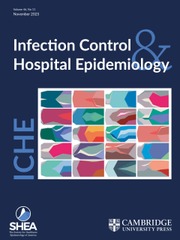Crossref Citations
This article has been cited by the following publications. This list is generated based on data provided by
Crossref.
McDonald, L. Clifford
2005.
Clostridium difficile: Responding to a New Threat From an Old Enemy.
Infection Control & Hospital Epidemiology,
Vol. 26,
Issue. 8,
p.
672.
Loo, Vivian G.
Poirier, Louise
Miller, Mark A.
Oughton, Matthew
Libman, Michael D.
Michaud, Sophie
Bourgault, Anne-Marie
Nguyen, Tuyen
Frenette, Charles
Kelly, Mirabelle
Vibien, Anne
Brassard, Paul
Fenn, Susan
Dewar, Ken
Hudson, Thomas J.
Horn, Ruth
René, Pierre
Monczak, Yury
and
Dascal, André
2005.
A Predominantly Clonal Multi-Institutional Outbreak ofClostridium difficile–Associated Diarrhea with High Morbidity and Mortality.
New England Journal of Medicine,
Vol. 353,
Issue. 23,
p.
2442.
McDonald, L. Clifford
Killgore, George E.
Thompson, Angela
Owens, Robert C.
Kazakova, Sophia V.
Sambol, Susan P.
Johnson, Stuart
and
Gerding, Dale N.
2005.
An Epidemic, Toxin Gene–Variant Strain ofClostridium difficile.
New England Journal of Medicine,
Vol. 353,
Issue. 23,
p.
2433.
Bartlett, John G.
and
Perl, Trish M.
2005.
The NewClostridium difficile— What Does It Mean?.
New England Journal of Medicine,
Vol. 353,
Issue. 23,
p.
2503.
Pepin, J.
Saheb, N.
Coulombe, M.-A.
Alary, M.-E.
Corriveau, M.-P.
Authier, S.
Leblanc, M.
Rivard, G.
Bettez, M.
Primeau, V.
Nguyen, M.
Jacob, C.-E.
and
Lanthier, L.
2005.
Emergence of Fluoroquinolones as the Predominant Risk Factor for Clostridium difficile-Associated Diarrhea: A Cohort Study during an Epidemic in Quebec.
Clinical Infectious Diseases,
Vol. 41,
Issue. 9,
p.
1254.
Dhalla, Irfan A.
Mamdani, Muhammad M.
Simor, Andrew E.
Kopp, Alex
Rochon, Paula A.
and
Juurlink, David N.
2006.
Are Broad-Spectrum Fluoroquinolones More Likely To Cause
Clostridium difficile
-Associated Disease?
.
Antimicrobial Agents and Chemotherapy,
Vol. 50,
Issue. 9,
p.
3216.
Chao, Hsun-Chin
Chen, Chien-Chang
Chen, Shih-Yen
and
Chiu, Cheng-Hsun
2006.
Bacterial enteric infections in children: etiology, clinical manifestations and antimicrobial therapy.
Expert Review of Anti-infective Therapy,
Vol. 4,
Issue. 4,
p.
629.
Boyce, John M.
Ligi, Cathy
Kohan, Cindy
Dumigan, Diane
and
Havill, Nancy L.
2006.
Lack of Association Between the Increased Incidence ofClostridium difficile–Associated Disease and the Increasing Use of Alcohol-Based Hand Rubs.
Infection Control & Hospital Epidemiology,
Vol. 27,
Issue. 5,
p.
479.
Raveh, David
Rabinowitz, Bella
Breuer, Gabriel S.
Rudensky, Bernard
and
Yinnon, Amos M.
2006.
Risk factors for Clostridium difficile toxin-positive nosocomial diarrhoea.
International Journal of Antimicrobial Agents,
Vol. 28,
Issue. 3,
p.
231.
Novak, Joshua
and
Katz, Jeffry A.
2006.
Probiotics and prebiotics for gastrointestinal infections.
Current Infectious Disease Reports,
Vol. 8,
Issue. 2,
p.
103.
Nielsen, Nathan D.
Layton, Blythe A.
McDonald, L. Clifford
Gerding, Dale N.
Liedtke, Laura A.
and
Strausbaugh, Larry J.
2006.
Changing Epidemiology of Clostridium difficile-Associated Disease.
Infectious Diseases in Clinical Practice,
Vol. 14,
Issue. 5,
p.
296.
Aslam, Saima
and
Musher, Daniel M.
2006.
An Update on Diagnosis, Treatment, and Prevention of Clostridium difficile–Associated Disease.
Gastroenterology Clinics of North America,
Vol. 35,
Issue. 2,
p.
315.
Stein, G. E.
and
Goldstein, E. J. C.
2006.
Fluoroquinolones and Anaerobes.
Clinical Infectious Diseases,
Vol. 42,
Issue. 11,
p.
1598.
Pepin, Jacques
2006.
Editorial Commentary:Improving the Treatment ofClostridium difficile–Associated Disease: Where Should We Start?.
Clinical Infectious Diseases,
Vol. 43,
Issue. 5,
p.
553.
Fordtran, John S.
2006.
Colitis Due toClostridium DifficileToxins: Underdiagnosed, Highly Virulent, and Nosocomial.
Baylor University Medical Center Proceedings,
Vol. 19,
Issue. 1,
p.
3.
Paterson, David L.
2006.
The Role of Antimicrobial Management Programs in Optimizing Antibiotic Prescribing within Hospitals.
Clinical Infectious Diseases,
Vol. 42,
Issue. Supplement_2,
p.
S90.
Valiquette, L.
Low, D. E.
Chow, R.
and
McGeer, A. J.
2006.
A survey of physician's attitudes regarding management of severe group A streptococcal infections.
Scandinavian Journal of Infectious Diseases,
Vol. 38,
Issue. 11-12,
p.
977.
Bhalla, Alka
2006.
Quinolones: A Nosocomial Risk Factor for Clostridium Difficile—Associated Diarrhea.
Canadian Pharmacists Journal / Revue des Pharmaciens du Canada,
Vol. 139,
Issue. 2,
p.
47.
Surowiec, Dorothy
Kuyumjian, Arpi G
Wynd, Michael A
and
Cicogna, Cristina E
2006.
Past, Present, and Future Therapies for Clostridium difficile–Associated Disease.
Annals of Pharmacotherapy,
Vol. 40,
Issue. 12,
p.
2155.
Cappelletty, Diane M
and
Zervos, Mark
2006.
Levofloxacin use in the elderly: focus on pneumonia.
Aging Health,
Vol. 2,
Issue. 3,
p.
371.




